Abstract
With a view of Georgian cinema under the current spotlights of various international film festivals, the author reviews the state of the art of Georgian film production, linking it to the impressively long history of Georgia’s cinematographic production. Recently, a targeted film promotion policy has focused on international co-productions and on fostering cooperative ventures with European partners. Among the young filmmakers a remarkably large proportion are female.
For some years Georgian feature films have been regular guests at international film festivals, and some of those films have even made it into German cinemas. That international presence is the result not least of a targeted film promotion policy that focuses on international co-productions and talented young filmmakers, of whom a remarkably large number are female. However, it should not be forgotten that Georgian cinema has a long history as changeful as the country itself.
Diversity and Censorship
In contrast to the cinematography of many other of the successor countries of the former socialist states of Europe, Georgian film profits from a mixture of various positive clichés. Between the sophisticated Black Sea coast and the rugged mountain landscapes of the Caucasus, Georgia has been considered a place of longing in both East and West, even during Soviet times. Although Stalin was born there and parts of the country still pay him homage, Georgia was always less about Stalin than about wine, song and ancient history—and about Sergei Parajanov. Parajanov (1924-1990), an Armenian born in Tbilisi, became one of the most acclaimed film directors of the Soviet Union and addressed the ethnic diversity of the Caucasus in his bizarrely artistic cinematography. The folkloristic, mysterious, and underneath it all quite secular work of the primitivist painter Niko Pirosmani (1862-1918) were long regarded as emblematic testimonies to a country that everyone loved without really knowing it. Giorgi Shengelaia (*1937) set up the first cinematic monument to the artist with his ‘Pirosmani’ of 1969. It explores Pirosmani’s intriguing mixture of both myth and objectivity, each of which the East and the West stood for in turn. Indeed, anyone would want to see films from such a country, and as Federico Fellini’s often-quoted piece of filmic wisdom has it, ‘Georgian film is a completely unique phenomenon, vivid, philosophically inspiring, very wise, childlike. There is everything that can make me cry and I ought to say that it (my crying) is not an easy thing.’[1]
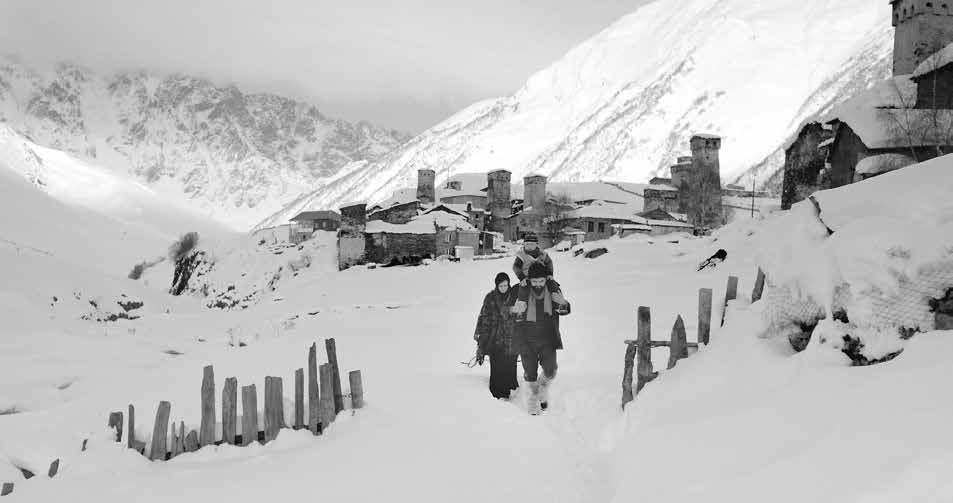
‘Dede’. Source: 20 Steps Productions.
Georgian film is certainly a mixture too of grotesque satire and the fascinating landscapes that make both the country’s film history and its contemporary cinema so popular. For example, Kote Mikaberidze (1896-1973) shot his biting comedy about bureaucracy, philistinism and careerism called ‘My Grandmother’ (‘Chemi Bebia’) there in 1929. Then in 1930, with ‘Salt for Svanetia’ (‘Jim Shvante’) about the harsh living conditions of the mountain dwellers of Svanetia in northwestern Georgia, the later cult Soviet director of ‘The Cranes are Flying / (‘Letyat Zhuravli’, 1957), Mikhail Kalatozov (*1903-1973), produced an early documentary classic.
Even in the early days of Georgian film, the different approaches to cinema in the Caucasian republic became apparent. Georgian filmmakers made it clear that the films they wanted to make were to be something special, in a different style from that of the Russian-dominated cinema elsewhere in the Soviet Union. Georgian filmmakers could not be induced to meet the ‘common denominator’ so often demanded by film publicists—Georgian cinema was too different, too diverse and its low annual production output assembled very different artistic signatures. It displayed a creative polyphony that was a thorn in the side of communist censorship, and not only in Georgia. For instance, ‘My Grandmother’ remained hidden away un-shown for almost half a century.
Names such as Tengiz Abuladze (1924-1994) who described his ‘Repentence’ (‘Monanieba’, 1984/1987) as a reappraisal of the Stalin era, ‘the first swallow of perestroika’, went down in international film history. Eldar Shengelaia (*1933) made the satire on bureaucracy ‘Blue Mountains, or Unbelievable Story’ (‘Tsisperi Mtebi Anu Daujerebeli Ambavi’, 1983/1984), which struck a chord especially with Eastern bloc audiences, before he embarked on a political career in the 1980s. Shengelaia played a key role in Georgia’s transformation and was once a high-ranking member of parliament.
Otar Iosseliani (*1934) emigrated to France in 1982, but not before he had made ‘Once Upon a Time There Was a Singing Blackbird’ (‘Iqo Shashvi Mgalobeli’, 1970) and a number of other films. ‘Once Upon a Time There Was a Singing Blackbird’ is the portrait of an idler, a workshy anti-hero who shirked his responsibilities to socialism. Deviation from the accepted course, the staging of the imperfect, constant searching; all are among the strengths of Iosseliani’s films, where instead of a narrative condensed into a message the viewer is offered many small stories that tell of the absurdities of everyday life and how the lust for life coexists with doubt.
Iosseliani first studied music, then mathematics, moving to the All-Union State Institute of Cinematography (VGIK) in 1955. The VGIK film academy is the oldest film school in the world, founded as the Moscow Film School in 1919 and since 1986 bearing the name Gerasimov Institute of Cinematography. Shortly after Stalin’s death in 1953 the faculty’s students began to reflect on the contradictions between the idea of socialism and its implementation. Iosseliani immediately fell foul of the authorities with his first film, ‘April’ (‘Aprili’) which was censored for ‘excessive formalism’. For a time, he worked as a fisherman and in the metal industry, though he made a medium-length feature film in 1962. However, that work was not released until 1972, so was not acclaimed internationally until after ‘Once Upon a Time there Was a Singing Blackbird’, which was successful at major festivals such as Cannes and Berlin. After Iosseliani left the Soviet Union for France he made films in Paris, the Basque Country, Tuscany and Venice, and revealed himself as one of the great European directors.
International Influences and Popularity
Georgian filmmakers have always been open to international influences. In the 1960s they were trained at the renowned VGIK in Moscow but studied in Tehran too, where they were infected with enthusiasm for the Italian neorealism, whose sparse, authentically lifelike black-and-white photography has revolutionized all of European cinematography since the 1950s, laying the foundation for the later cinema of the ‘auteur’ and contributing significantly to establishing the filmmaker as sceptical observer of every state order and as critical companion of social phenomena, as well as questioner of historical processes.
The fact that Georgian cinema is so popular in Germany is due not least to the husband and wife team Erika and Ulrich Gregor, founders of the Berlin ‘Arsenal’ cinema and the International Forum of Young Cinema (short simply ‘Forum’) at the Berlinale. Since the 1960s the Gregors have taken a special interest in Georgian cinema so that today, alongside the Russian State Film Archive Gosfilmofond in Moscow, the film archive of the ‘Arsenal’ holds the largest collection of Georgian films outside Georgia. For the ‘German-Georgian Year’ in 2017 the ‘Arsenal’ showed a major retrospective from its collection, three of the films having been digitally restored with funds from the Cultural Preservation Programme of the Federal Foreign Office of Germany. Among the films shown were Merab Kokochashvili’s (*1935) ‘The Big Green Valley’ (‘Didi Mtsvane Veli’, 1967), a drama about an outsider influenced by neorealism in the field of tension between tradition and progress; and ‘On the Borderline’ (‘Zghvarze’, 1993) by Dito Tsintsadze’s (*1957) in which a young physicist comes under pressure in the social atmosphere of an imminent civil war.
In 2018, Georgia will once again be the focus of European media attention as it will be guest of honour at the renowned Frankfurt/Main book fair in October. In May 2018, the FilmArtFestival Mecklenburg-Pomerania in Schwerin dedicated a small retrospective to Georgia as a country of creative film[2] and from 6 to 11 November 2018 the FilmFestival Cotbus, which is entirely dedicated to East European cinema, will follow suit and throw its spotlight onto Georgian film.[3]
The current heyday of Georgian cinema is based on the country’s controversial national history too. During socialism, films taking a sceptical view of everyday life and history came to the attention of the censors or were withheld from public view for the flimsiest of reasons. For instance, Abuladze’s ‘Repentence’ was released only in 1987, three years after its completion. Nana Djordjadze’s (*1948) diploma film about two outsiders, ‘A Journey to Sopot’ (‘Mogzauroba Sopotshi’, 1979) remained banned for seven years while her first feature film ‘Robinsionada, or My English Grandfather’ (‘Robinzoniada Anu Chemi Ingliseli Papa’, 1987) had to undergo cuts before she was allowed to accept an invitation to the Cannes Film Festival. Noutsa Gogoberidze’s (1902-1966) poetic pioneering documentary ‘Buba’ about the living conditions of women, shot in 1930, was long considered lost before being rediscovered a few years ago. With ‘Ill-Tempered’ (‘Uzhmuri’) made in 1934, Gogoberidze was the first woman in the Soviet Union to make a feature film, while her daughter Lana Gogoberidze (*1928) re-addressed women’s matters in 1978 with ‘Some Interviews on Personal Matters’ (‘Ramdenime Interviu Pirad Sakitkhebze’). Her portrait of a journalist forced to choose between family and career is today considered one of the most prominent examples of early feminist perspectives in the Soviet cinema of the time. Like some of her fellow directors Gogoberidze tackled her subject with a mixture of psychological sensitivity and subliminal humour; the film’s criticism of the ruptures in everyday socialist life runs at the personal level, but with a high potential for identification with the audience.
Political Disengagement from Russia
Georgia’s history after the fall of the so-called Iron Curtain has been marked by numerous violent conflicts. In December 1991 the authoritarian president Swiad Gamsachurdia assumed power after a coup d’état; in 1992 war in Abkhazia led to the de facto secession of that part of Georgia; and in South Ossetia too there were military conflicts involving pro-Russian separatists. From the mid-1990s onwards dissatisfaction grew with the increasingly authoritarian style of government of then President Eduard Shevardnadze, who was replaced by Mikheil Saakashvili in 2003 after the so-called ‘Rose Revolution’. Saakashvili fought the ubiquitous corruption which the population held to blame for the country’s economic weakness and attendant poverty. He pushed forward rapprochement with the West, which had already begun under the Shevardnadze government and was linked to further liberation from dependence on Russia. Finally, in 2008 a military confrontation with Russia broke out after violent conflicts with South Ossetian separatists. While there are still different versions of events, there can be no doubt that the so-called ‘August War’ led to Georgia’s further separation from Russia. For its part, Saakashvili’s directive that every Georgian should learn English has further undermined the dominance of Russian as the lingua franca in international dialogue, and with it Russia’s influence in favour of that of western Europe and the USA. That has naturally had consequences for Georgian cinema too, as the Georgian film scene’s close ties with Russia were soon almost completely undone, whether through cessation of joint productions and of the education of Georgian filmmakers in Russian film schools, or the ending of location shooting by Russian film teams in Georgia. Meanwhile, the Georgian film industry increasingly sought contacts with Central European and Western partners.
In the decade since the ‘August war’ Georgia has been decoupled from the Russian film market too, which until then had guaranteed a supply of copies of Hollywood blockbusters and other big international film hits. In response, a number of Georgian cinema operators started to co-finance films themselves, so that since 2008 a market for commercial national cinema has developed in Georgia, albeit on a low-budget level. Artistically, Georgian cinema was still traumatized by the civil war years between independence in 1991 and the ‘Rose Revolution’ of 2003. Well-known directors like Nana Djordjadze or Dito Tsintsadze, who enjoyed a success in Germany with ‘Lost Killers’ in 2000, went abroad. Djordjadze, known for her profound and lively large-scale international productions, returned to Georgia only in 2008 to shoot her German-Italian-Russian-Dutch-Finnish co-production ‘The Rainbowmaker’. Now, talented younger directors like Gio Mgeladze (*1969), who produced ‘No, Pal’ (‘Ara, Megobaro’) in 1993, or Vakhtang Varazi (‘The Birthday’ / ‘Dabadebis dghe’, 1994) belong to what is called the ‘lost generation’, whose career opportunities vanished in the conflicts of the mid-nineties.
Vano Burduli (*1974) too belongs to that generation. His ‘The Conflict Zone’ (‘Konphliqtis Zona’, 2009) is set in the bloody 1990s and shows impressively the disruption between urban Tbilisi and its war-torn hinterland. Since the ‘August events’, certain Georgian filmmakers have given poignant focus to the fragile social balance in their country. For example, in 2008 Zaza Rusadze (*1974) who trained at the Film School Konrad Wolf in Potsdam-Babelsberg (now Film University Babelsberg Konrad Wolf), addressed the subject of grief in his short film ‘Folds and Cracks’ (‘Naketsebi Da Bzarebi’)—two variations on the loss of any vision of civil society. A few years later, Rusadze released his first feature film called ‘A Fold in My Blanket’ (‘Chemi Sabnis Naketsi’, 2013), the first Georgian film dealing openly with homosexuality. In 2011, ‘5 Days of August’, an American-Georgian production directed by the Finnish director Renny Harlin (*1959), tackled the Georgian-Russian war. As it happens, what might have been an illuminating view of Georgia from abroad is but a pathetic ‘action film’ pitched somewhere between the martyr-myth and the Saakashvilitransfiguration, one of only a few films that look at Georgian history in a one-dimensional and one-sided way, like a woodcut. Perhaps unsurprisingly the film never achieved great popularity.
Generation Europe
With the establishment of the Georgian National Film Center in Tbilisi in 2001 an important foundation stone was laid for the concentration of film production and the promotion of Georgian cinema, and between 2006 and 2009 the budget for film funding tripled. Officially independent of the Ministry of Culture, for many years the Film Center’s work, similarly to that of other similar postcommunist institutions, was marked by lack of transparency and a certain nepotism. However, in 2010 internationally experienced producer Tamara Tatishvili was appointed director. She set about reforming Georgia’s film support system from within and introduced her country to European film support mechanisms such as Eurimages and the MEDIA programme of the European Commission. In an interview with the film industry portal ‘Film New Europe’, Tatishvili described her strategic goal of integrating Georgia into the European co-production landscape:
‘European coproduction is the future of sustainable development of the Georgian film sector. Due to the small and relatively underdeveloped distribution market, as well as limited financial support to production, European coproduction will certainly add value to local film output. It will also bring benefits to European countries, which are constantly looking for ‘fresh blood’ and new stories. On the one hand, Georgia being located on the crossroads of Europe and Asia, allows for the films to be set with universal appeal, it truly represents uniqueness of two continents in terms of landscape, architecture and culture. Therefore it is cinematically appealing territory for international productions.‘[4]
Among the directors who have benefited from the new co-production agreements between Georgia and Europe is George Ovashvili (*1963). He learned his directing skills in the 1990s while the various wars were raging in his country. In ‘Corn Island’ (‘Simindis Kundzuli’, 2014) with minimalist poeticism he described the struggle for survival of a grandfather and his granddaughter caught between the military fronts and against the forces of nature. The film is set entirely on a small island in the river Enguri which divides Abkhazia from the Georgian heartland and was released in German cinemas in 2015 after receiving various awards.
‘Corn Island’ was only one of many Georgian films that have successfully toured the international film festivals recently. Works as diverse as Rusudan Pirveli’s (*1975) everyday portrait ‘Susa’ (2010) with its neorealist touch, the coming-of-age story ‘In Bloom’ (‘Grdzeli Nateli Dgheebi’, 2014) by Nana Ekvtimishvili (*1978), and German director Simon Gross’s (*1976) and Levan Koguashvili’s (*1973) ‘slacker movie’ ‘Blind Dates’ (‘Brma Paemnebi’, 2014). Underscored with subtle irony, that film alone demonstrates how diverse current Georgian cinema is. With precise social considerations and their ironic reinforcement of cleverly pointed, playfully staged everyday grotesques, a new generation of Georgian filmmakers have continued the successful years that came before the collapse of the Soviet Union.
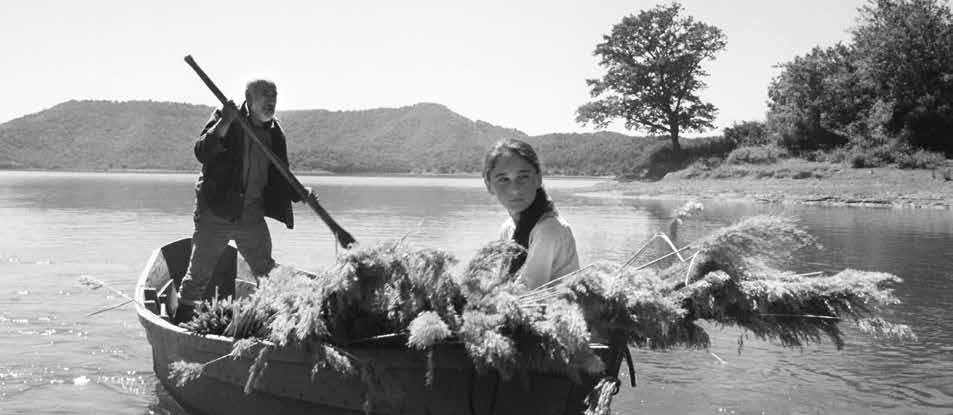
‘Corn Island’ (‘Simindis Kundzuli’). Source: Alamdary Film.
Ovashvili’s first feature film ‘The Other Bank’ (‘Gaghma Napiri’, 2009) was invited to over 80 festivals. The film tells the story of 12-year-old Tedo who has fled with his mother from his Abkhazian homeland to the capital Tbilisi after the outbreak of war. In search of his father, Tedo makes his own way back to his birthplace of Tkvarcheli, and the film describes the boy’s journey through a war-torn country. Ovashvili does not focus purely on suffering, but on Tedo’s encounters with others on his trek. He interacts with his peers, whose prejudices against the Abkhazians he does not share; falls in with some petty criminals who are hardly older than he is and meets some enemy soldiers who, he finds, sing the same songs and dance the same dances as do he and his people.
After a long search for a theme for his first feature film, Ovashvili found inspiration for ‘The Other Bank’ in the novella ‘Journey to Africa’ by the Georgian writer and actor Nugzar Shataidze, who was also involved in the scripts of Ovashvili’s first two feature films. ‘No matter which side they were on, children were the losers of the war,’ says Ovashvili, suggesting that he prefers to remain neutral himself: ‘The moment you stand on one side as a filmmaker, it’s over.’[5]
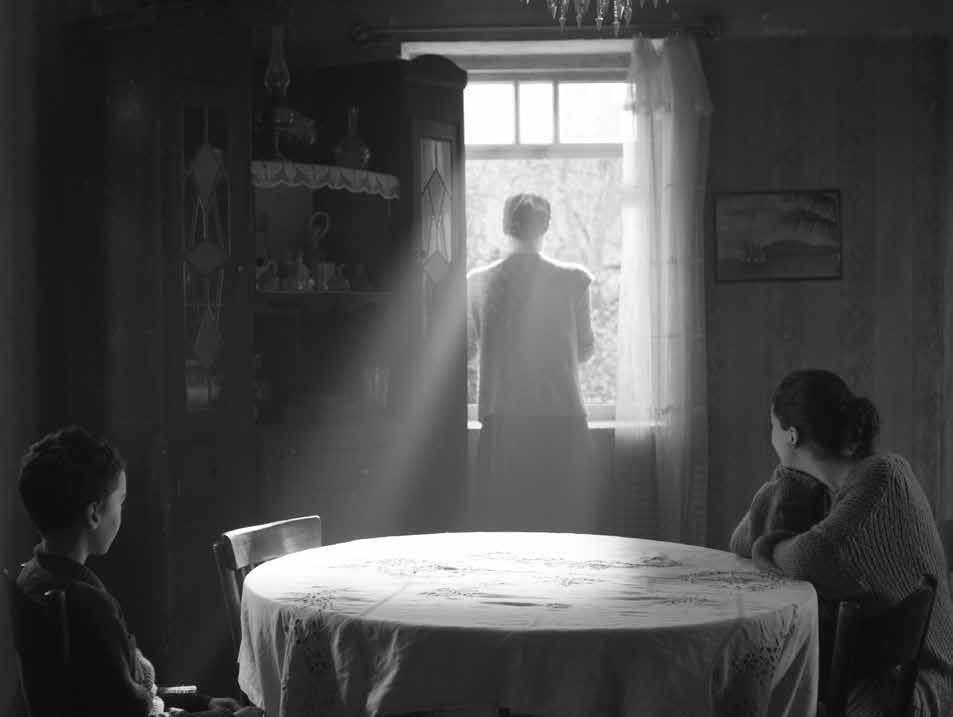
‘House of Others’ (‘Skhvisi Sakhli’). Source: Georgian National Film Center.
Although that stance brought the accusation in his homeland that he was ‘insufficiently pro-Georgian’, it did help to conduct the discourse on war beyond inculcated friend-foe patterns. ‘That many from the Abkhazian side have seen the film and liked it,’ he adds, ‘shows that there is always a way to talk to each other instead of shooting at each other.’ However, his dream of producing his first feature film at original locations in Abkhazia proved to be a vain hope.
Co-Productions for Social Debate
In 2012 a total of twelve feature films were produced in Georgia; in 2017 there were 20, while over the same time the number of screens increased. In 2007 there were just three cinemas in regular operation in the whole of Georgia, but now there are 23. Between 2012 and 2016 cumulative box office takings have increased by 52% as the number of paying viewers has risen from 0.6 to 1.15 million.[6] Although the increase in admissions was due mainly to the establishment of multiplex cinemas focusing on the screening of major international commercial productions, the success of Georgian domestic cinema at international festivals is likely to have made its own significant contribution to increasing the attractiveness of the medium of film. Most Georgian films were made as international co-productions, mainly with France, Germany, and Estonia.
Today, Georgian filmmakers follow the fine tradition of their Soviet predecessors, commenting on political, social, and historical phenomena and intervening in social debates, always trying to make their viewers think. That most of the currently internationally successful Georgian films were directed by women is probably the result of Tamara Tatishvili’s policy of targeted support. Tatishvili has since resigned her post as director of the Georgian National Film Center, and she has been succeeded on a rotational basis by Nana Janelidze and Zurab Maghalashvili. The British daily newspaper The Guardian celebrated the 50% participation of women in the Georgian Film Festival in London in May 2018 and called Georgia’s an exemplary film industry that is ‘putting Cannes to shame’.[7]
Female-Led Cinematography?
Women directors, also typically of a country that refuses to be reduced to a single theme—in matters other than film, too—deal with very different themes. Nino Basilia in ‘Anna’s Life’ (‘Anas Tskhovreba’, 2016) sketches a social portrait of a single mother fighting for survival in a patriarchal environment. In ‘House of Others’ (‘Skhvisi Sakhli’, 2016) Rusudan Glurjidze (*1972) offers an impressively atmospheric study of a family who move after the war to a village in which the houses had previously been inhabited by ‘the enemy’. Mariam Khatchvani’s (*1986) ‘Dede’ (2017) is about a young woman in a remote Svanetian village. She had been promised in marriage to a returning war veteran, but instead loves his comrade. In ‘Scary Mother’ (‘Sashishi Deda’, 2017), Ana Urushadze (*1990) portrays a 50-year-old housewife who has to choose between her socially prescribed duties as a housewife and her true passion, writing. An analogous topic is taken up by the Georgian-German directing couple Nana Ekvtimishvili and Simon Gross in ‘My Happy Family’ (‘Chemi Bednieri Ojakhi’, 2017). There too, the protagonist is a housewife in her prime who surprisingly announces to her family that after thirty years of marriage she intends to leave the flat they all share to search for her own fulfilment. Producer/director Tinatin Kajrishvili (*1978) has directed two feature films, ‘Brides’ (‘Patardzlebi’, 2014) being a portrait of a family whose everyday life would be quite normal were it not that their father is in prison; and the contemplative ‘Horizon’ (‘Horizonti’, 2018) which reflects on the end of a relationship.
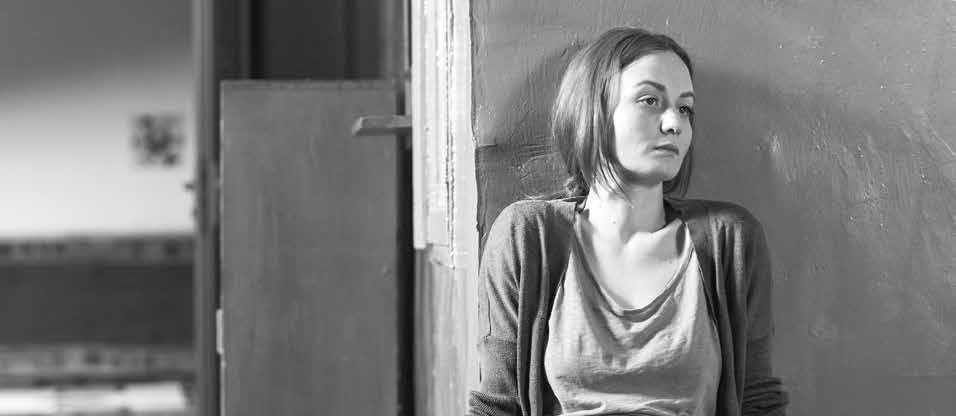
‘Anna’s Life’ (‘Anas Tskhovreba’). Source: New Morning Films.
These are films that seem to be taken from the midst of life, far away from pathos and pamphlets. The young generation of Georgian women directors animate their themes with serious freshness and at the same time in detail just as accurate as that of the older generation of Georgian filmmakers around Gogoberidze and Djordjadse. These films by today’s women are also just as full of humour—sometimes deeply subtle, sometimes sheer burlesque. With great psychological sensitivity they observe communication and its difficulties closely among individuals, and then there comes a point when they reach for the broadest brush. For example, in ‘In Bloom’, the key scene is when Eka, the teenage girl protagonist, provokes all her relatives by performing an initiation dance that should actually be reserved for men. The scene shows the young heroine’s defiant will to assert herself in the patriarchal atmosphere of what was almost civil war in 1992 and is just as intriguing as the inner division shown between tradition and emancipation. It is certainly among the film scenes of the Berlinale 2013 that will remain in the audience’s memory for a long time. In fact, the female heroines in contemporary Georgian cinema all show a desire to free themselves of their prescribed social roles, although more often than not in the end convention proves too strong.
Could it be that the typical professional doubts of the filmmakers’ guild come into play again here? The young musician Gia in Iosseliani’s almost fifty-year-old ‘Once Upon a Time there Was a Singing Blackbird’ was driven not only by his desire to free himself, but also by self-doubt. ‘Is my way out of society really the right way?’, he asks himself. ‘How much freedom do I have left if I fulfil only myself? And how do I balance my own desire to assert myself with the social necessity of assuming responsibility?’ It was and is a great merit of Georgian feature film that it balances ethical questions like that in several ways, both thoughtfully and entertainingly, and without the political finger-waving so beloved of filmmakers from the West.
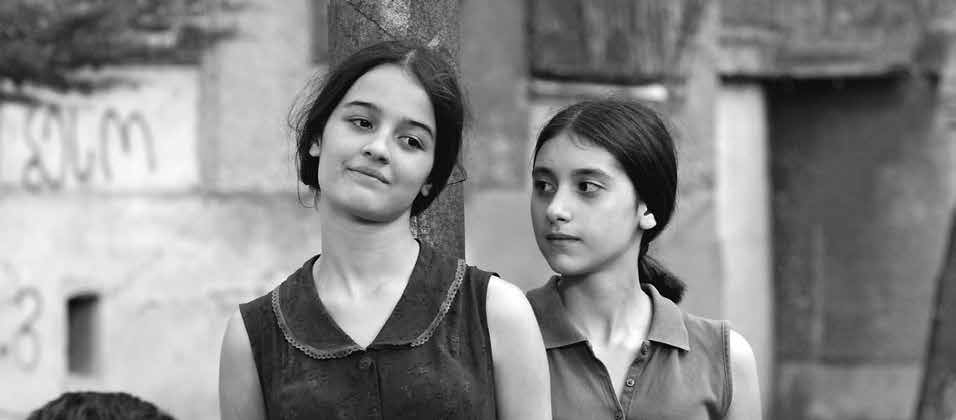
‘In Bloom’ (‘Grdzeli Nateli Dgheebi’). Source: Georgian National Film Center.
Continuing the ‘Completely Unique’?
Looking at Georgian film history we may say in summary that feature film there was always and still is permanently striving to emancipate itself from its social conditions. A glance at documentary film-making, which unfortunately could not be taken into account in this treatise, confirms as much. Georgian filmmakers have always tried to critique their country’s history and its present, and in doing so they meet their audience’s wish for a visually sophisticated, entertaining auteur’s cinema. Audiences wanted original narratives, with often playful and pictorial approaches—indeed something ‘completely unique’, as Fellini put it.
But will that remain so? After a number of Georgian feature films had toured the international film festivals in competition with each other during 2016 and 2017, in 2018 a creative break can be observed. With ‘Khibula’ (2017) George Ovashvili presented a new film about a retired president and his entourage who are fleeing from their people. In the film’s captivatingly beautiful photography only men play the main roles, while from time to time women are brought on to serve the fugitive ex-politician tea and liquor. Zaza Khalvashi’s (*1957) ‘Namme’ (2017) is a mythological portrait of a woman who takes over from her father the task of ensuring the purity of water—an almost hopeless undertaking in view of the planned construction of a hydroelectric power plant. In 2013, with the Estonian-Georgian co-production ‘Tangerines’ (‘Mandarineb’), Zaza Urushadze (*1965) made a film about a chance acquaintance between an Estonian-born tangerine farmer and an Abkhazian separatist. The film is an impressive humanist chamber piece about war, retribution, and forgiveness, and its quality brought Urushadze an Academy Award nomination for ‘Best Foreign Film’. However, in his current feature, ‘The Confession’ (‘Beri’, 2017), Urushadze reactivates long-forgotten backward-looking images of women. In a remote village, the local music teacher Lili—who rather amazingly closely resembles Marylin Monroe in ‘Some Like It Hot’—seals the fate of the new priest. After he resists her attempts at seduction she pretends he raped her. ‘The Confession’ is therefore the polar opposite of the sensitively staged ‘Tangerines’, for instead of questioning prejudices, Urushadze circles the cliché of the seductive, sneaky blonde who engineers the downfall of an honest Christian priest.
At present, Urushadze’s new film project, currently in development, will tell the story of ‘Anton, His Friend, and the Russian Revolution’. It will be a historical film showing how a German community near Odesa falls victim to invading Bolsheviks at the end of the First World War. A Ukrainian-Georgian co-production, on the Georgian side it was developed by the producer of ‘5 Days in August’. Ostensibly, attention is directed towards the message of the historical events shown, but between the lines its main concern is to address Georgian fear of the omnipresent imperialist neighbour, Russia. Such projects leave a trace of something which so far in Georgian cinema has hardly played a role—in contrast to the cinematography of other countries neighbouring Russia, such as the Baltic states. Visible here is the trace of Georgia’s defensive nationalism, as it has been derived both from historical experience and from the country’s current fear of Russian aggression.
And what of the old masters? In 2017, Eldar Shengelaia filmed ‘The Chair’ (‘Skami’), a television comedy about a corrupt ‘Refugee Eviction Minister’ whose luxurious office chair develops a life of its own and starts to take its own decisions about the arrogant politician’s well-being. Unfortunately, the attempt to transfer the satirical joke of ‘Blue Mountains, or Unbelievable Story’ to the political culture of the postcommunist clamour to get on the career ladder failed, descending into silly jokes and anecdotal buffoonery. The wonderful Nana Djordjadze presented her last feature film to date in 2013. ‘My Mermaid, my Lorelei’ (‘Moya Rusalka, Moya Lorelyay’) was created shortly before Russia’s annexation of Crimea and turned out to be one of the last Ukrainian-Russian co-productions. The vivid, imaginative coming-of-age story about the affection between 14-year-old Fedor and 18-year-old Nyurka is not least a celebration of diversity, a paean to the vibrant multiculturalism of the Ukrainian metropolis port of Odesa.
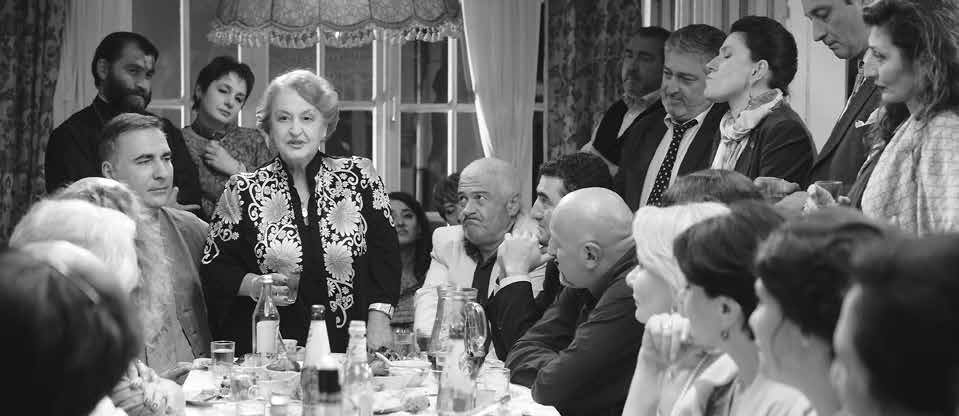
‘My Happy Family’ (‘Chemi Bednieri Ojakhi’). Source: Zorro Film.
Hope for New Co-Production Opportunities
Georgian cinema today continues to refer to its non-conformist roots, its artistic and content-related diversity on the back of which almost every one of the comparatively few feature films produced here has become a success. Young directors, including female directors to an extent rarely seen in Eastern Europe, have benefited above all from the turn towards Western and Central European co-production partners who have become associated with separation from Russia. The future will depend on how well the film promotion budget in this relatively small Caucasian country can be stabilised, and how far international co-producers are willing to invest in Georgian films. To help with that there are key events advertising the Georgian film industry, its players and its talents, such as the annual Tbilisi International Film Festival. The Festival, taking place in early December, is world-renowned and invites a considerable number of international industry representatives in the hope of sparking interest in cooperation with Georgia. There is too the Batumi International Arthouse Film Festival which was founded in 2012 and which as one of its features has established a film industry platform under the name ‘Alternative Wave’.
As part of its ‘Industry Day’ the festival in the Georgian capital of Tbilisi presents the upcoming projects of young filmmakers from Georgia which are still in their script development phase. There too the hope lies in establishing cooperative connections with European partners. This young generation of filmmakers, few of whom seem even to speak Russian anymore, appear to have abandoned completely the old idea of regional co-productions with their huge neighbouring country. However, partnerships with other countries in the immediate vicinity have proved difficult to arrange as markets are too small. Added to that difficulty are languages which vary too much and cultural characteristics too dissimilar for a common film language to be found. However, the leading film festival in Armenia, the Golden Apricot International Film Festival (GAIFF) in Yerevan, this year launched a co-production market under the brand ‘GAIFF pro’. Its aim is to bring closer the film industries of the Lesser Caucasus—meaning Armenia, Azerbaijan, Iran, Turkey, and Georgia.
To be sure, the politically determined and deliberately caused implosion of the joint Russian-Georgian production history has occasionally been at least partially restored by Georgian-born filmmakers such as Bakur Bakuradze (*1969) who works in Russia. In 2015 Bakuradze made the Russian-Serbian co-production ‘Brother Deyan’ (‘Brat Deyan’). The film is an intellectually demanding disquisition on the state-tolerated hide-and-seek of a war criminal from the wars of disintegration in former Yugoslavia. Clearly therefore, new co-production alliances have in fact emerged.
Georgia has thus grown from being an exotic country on the periphery of Europe to become a full member of the European film community. While certain of the youngest representatives of current Georgian filmmakers do indeed complain behind closed doors that their cinema is still not European enough and, like their country’s tourism advertising still relies too much on ‘folklorism’, nevertheless their criticism does after all continue the tradition of sceptical observation which has made of Georgian filmmakers such reliable social and political barometers of their country’s social fabric. We may then feel optimism that Georgian film will persevere with its traditional creative independency into the future.
© 2018 Walter de Gruyter GmbH, Berlin/Boston
Articles in the same Issue
- Frontmatter
- Corruption in Southeastern Europe and Latin America
- Corruption in Southeastern Europe and Latin America. An Introduction
- The Ideological Malleability of Corruption. A Comparative Analysis of Official Corruption Discourses in Albania and Colombia, 2010-2017
- Turkeys Do Not Vote for Christmas. The Brazilian Anti-Vote-Buying Law
- ‘One Does Everything to Make Life Better.’ Petty Corruption and Its Legal Implications in Hungary
- Not-So-Informal Relationships. Selective Unbundling of Maternal Care and the Reconfigurations of Patient–Provider Relations in Serbia
- Questioning Anticorruption in Postcommunist Contexts. Romanian MPs from Commitment to Contestation
- Future Challenges of Corruption Studies
- Open Section: Film in Focus
- ‘Georgian Film Is a Completely Unique Phenomenon.’ A Film Scene with History, or Georgian Cinema in the Emancipation Loop
- Open Section: Book Reviews
- Building Democracy in the Yugoslav Successor States. Accomplishments, Setbacks, Challenges since 1990
- Die Balkankrisen von 1908-1914 und die Jugoslawienkonflikte von 1991-1999 im Beziehungsgeflecht der Großmächte. Das Verhalten von internationalen Akteuren bei der Ausbreitung von Konflikten auf dem Balkan
- Replicating Atonement. Foreign Models in the Commemoration of Atrocities
- EU, Europe Unfinished. Mediating Europe and the Balkans in a Time of Crisis
Articles in the same Issue
- Frontmatter
- Corruption in Southeastern Europe and Latin America
- Corruption in Southeastern Europe and Latin America. An Introduction
- The Ideological Malleability of Corruption. A Comparative Analysis of Official Corruption Discourses in Albania and Colombia, 2010-2017
- Turkeys Do Not Vote for Christmas. The Brazilian Anti-Vote-Buying Law
- ‘One Does Everything to Make Life Better.’ Petty Corruption and Its Legal Implications in Hungary
- Not-So-Informal Relationships. Selective Unbundling of Maternal Care and the Reconfigurations of Patient–Provider Relations in Serbia
- Questioning Anticorruption in Postcommunist Contexts. Romanian MPs from Commitment to Contestation
- Future Challenges of Corruption Studies
- Open Section: Film in Focus
- ‘Georgian Film Is a Completely Unique Phenomenon.’ A Film Scene with History, or Georgian Cinema in the Emancipation Loop
- Open Section: Book Reviews
- Building Democracy in the Yugoslav Successor States. Accomplishments, Setbacks, Challenges since 1990
- Die Balkankrisen von 1908-1914 und die Jugoslawienkonflikte von 1991-1999 im Beziehungsgeflecht der Großmächte. Das Verhalten von internationalen Akteuren bei der Ausbreitung von Konflikten auf dem Balkan
- Replicating Atonement. Foreign Models in the Commemoration of Atrocities
- EU, Europe Unfinished. Mediating Europe and the Balkans in a Time of Crisis

